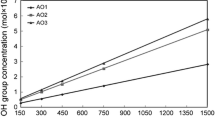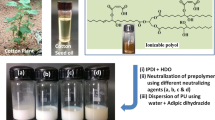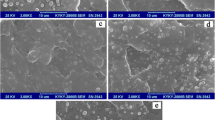Abstract
The effects of water and carbonyl sulfide (COS) in propylene feed of polymerization process were examined in relation to the physical and mechanical properties of synthesized polypropylene (PP). The Samples were analyzed using gel permeation chromatography, scanning electron microscopy (SEM), differential scanning calorimetry (DSC), X-ray diffractometry (WAXS) and mechanical test. Molecular mass and isotacticity of PP were reduced by increasing poisons due to the limitation of the movement of polymer chains. The SEM images indicated that the effect of water and COS poisons on polymer morphology was insignificant. The results of DSC and optical tests revealed that an increase in water and COS poisons significantly increased the transparency of PP, which had been originated from the reduction of surface irregularities caused by escalated polymer atacticity. Nevertheless, the improvement in optical properties was very little for other properties, such as gloss and yellow index. The XRD results confirmed lower crystallinity due to escalated atacticity because of increased poisons. Furthermore, comparison of poison-contained and poison-free samples indicated that an increase in the amount of poisons led to greater tensile strength and heat distortion temperature (HDT). Since it is crucial to achieve the ultimate properties of the polymer, mechanical properties of the polymer should be considered to achieve improved transparency.






Similar content being viewed by others
References
Cong Y, Hong Z, Zhou W, Chen W, Su F, Li H, Li X, Yang K, Yu X, Qi Z, Li L (2012) Conformational ordering on the growth front of isotactic polypropylene. Spherulite. Macromol 45:8674–8680
De Rosa C, Auriemma F, Di Girolamo R (2013) Morphology and mechanical properties of the mesomorphic form of isotactic polypropylene in stereodefective polypropylene. Macromolecules 46:5202–5214
De Rosa C, Auriemma F, Di Girolamo R (2008) The double role of comonomers on the crystallization behavior of isotactic polypropylene: propylene-hexene copolymers. Macromolecules 41:2172–2177
Taghaddosi S, Akbari A, Yegani R (2017) Preparation, characterization and anti-fouling properties of nanoclays embedded polypropylene mixed matrix membranes. Chem Eng Res Des 125:35–45
Nakamura K, Shimizu S, Umemoto S, Thierry A, Lotz B, Okui N (2008) Temperature dependence of crystal growth rate for [alpha] and [beta] forms of isotactic polypropylene. Polym J 40:915–922
Zia Q, Androsch R, Radusch H-J, Piccarolo S (2006) Morphology, reorganization and stability of mesomorphic nanocrystals in isotactic polypropylene. Polymer 47:8163–8172
Gadzinowska K, Piorkowska E (2003) Influence of sample thickness and surface nucleation on i-PP crystallization kinetics in DSC measurements. Polimery 48:790–799
Funaki A, Takubo T, Kanai T (2016) Experimental analysis for extrusion screw geometry to produce highly transparent polypropylene sheets. Polym Eng Sci 50:420–427
Sun C, Chen H, Guo B, Song G, Li P, Li Y, Gao J (2016) Changes of optical properties in the aging process of polypropylene. J Food Saf Qual 7(3):1203–1209
Xinli X, Xueying Q, Deyan K, Wenbo Z (2016) Optically transparent high temperature shape memory polymers. Soft Matter 12:2894–2900
Paulino C (2016) Biaxially oriented high density polyethylene film with improved sealant layer. Mater Des 103:32-39. Paulino CM, inventor; Toray Plastics (America) Inc, assignee. Biaxially oriented high density polyethylene film with improved sealant layer. United States patent US 9,676,169. 2017
Feldmann M (2016) The effects of the injection moulding temperature on the mechanical properties and morphology of polypropylene man-made cellulose fibre composites. Appl Sci Manufact 87:146–152
Barbe PC, Cecchin G, Noristi L (1987) The catalytic system Ti-complex/MgCl 2. In catalytical and radical polymerization. Springer, Berlin, Heidelberg, pp 1–81
Terano M, Soga K (1994 Nov 1) Catalyst design for tailor-made polyolefins. Elsevier
Pino P, Cioni P, Wei J (1987) Asymmetric hydrooligomerization of propylene. J Am Chem Soc 109:6189–6191
Maddah HA (2016) Polypropylene as a promising plastic: A review. Am J Polym Sci 6:1):1–1):1
De Santis F, Pantani R (2013) Optical properties of polypropylene upon recycling. Sci World J. https://doi.org/10.1155/2013/354093
Shibayama M, Imamura K-I, Katoh K, Nomura S (1991) Transparency of recycled polypropylene film. J Appl Polym Sci 42:1451–1458
Sukhadia A-M, Rohlfing D-C, Johnson M-B, Wilkes G-L (2002) A comprehensive investigation of the origins of surface roughness and Haze in polyethylene blown films. J Appl Polym Sci 85:2396–2411
Miwa T, Masayuki Y (2007) Structure and properties of injection-molded polypropylene with sorbitol-based clarifier. Polym Eng Sci 47:1441
Ahmad Z, Kumar K-D, Saroop M, Preschilla N, Biswas A, Bellare J-R, Bhowmik A (2010) Highly transparent thermoplastic elastomer from isotactic polypropylene and styrene/ethylene-butylene/styrene triblock copolymer: structure-property correlations. Polym Eng Sci 50:331–341
Stockland R-A, Foley S-R, Jordan R-F (2003) Reaction of Vinyl Chloride with Group 4 Metal Olefin Polymerization Catalysts. J Am Chem Soc 125:796–809
Bernland K, Goossens J, Smith P, Tervoort T (2016) On clarification of haze in polypropylene. J Polym Sci 54:865–874
Li X, Guo C, Zhang Y, Liu K, Zhang J (2015) The morphology and mechanical properties of isotactic polypropylene injection-molded samples with the presence of β-nucleation agent and periodical shear field. J Macromol Sci Part B 54:215–229
Janiak C, Blank F (2006) Metallocene catalysts for olefin oligomerization. InMacromolecular symposia 236(1) 14-22. Weinheim: WILEY-VCH Verlag.
Quijada R, Rojas R, Bazan G, Komon ZJA, Mauler RS, Galland GB (2001) Synthesis of branched polyethylene from ethylene by tandem action of iron and zirconium single site catalysts. Macromolecules 34:2411–2417
Lin CY, Chen MC, Mehta AK (2001) Assessment of Metallocene Propylene Polymers for Cast Film Applications. J Plast Film Sheet 17:113–127
DeMeuse TM (2002) Processing and Film Properties of Polypropylene Made Using Metallocene Catalysts. J Plast Film Sheet 18:17–23
Crosby CR, Chatterjee AM (2001) Effect of Formulation Parameters on Optical and Frictional Properties of Tubular Water Quenched Polypropylene Films. J Plast Film Sheet 17:128–151
Xu T, Yu J, Jin Z (2001) Effects of crystalline morphology on the impact behavior of polypropylene. Mater Des 22:27–31
Gocek I, Adanur S (2009) Effect of processing parameters on polypropylene film properties. InThe Fiber Society 2009 Fall Meeting and Technical Conference, The University of Georgia, Athens, GA
Fatahi S, Ajji A, Lafleur P-G (2005) Correlation between structural parameters and property of PE blown films. J Plast Film Sheeting 21:281–305
Khanarian G (2000) Rubber toughened and optically transparent blends of cyclic olefin copolymers. Polym Eng Sci 40:2590–2601
Trezza TA, Krochta JM (2001) Specular reflection, gloss, roughness and surface heterogeneity of biopolymer coatings. J Appl Polym Sci 79:2221–2229
Darncholvichit M (2003) Haze band formation and morphological composition in blown film extrusion. University of Massachusetts Lowell, Lowell
Wang L, Kamal M-R (2001) Light transmission and haze of polyethylene blown thin films. Polym Eng Sci 41:358–372
Rinker JW (1979) Surface properties of blown low density polyethylene films. Paper synthetics conference, Proceedings of the Technical Association of the Pulp and Paper Industry, Washington, DC, USA, pp 129–136
Stehing FC, Speed CS, Westerman L (1981) Causes of haze of low-density polyethylene blown films. Macromolecules 14:698–708
Harban A-A, Samuel R (1967) Polymerization of olefins in the presence of a coordination catalyst and carbonyl sulfide, US Patent 3317502 A
Garoff T, Liskola E, Sormunen P(1987) Transition metals and organometallics as catalysts for olefin polymerization, ed. by Kaminsky, W and Sinn H, Springer-Verlag, Berlin, p.197.
Tangjituabun K, Kim SY, Hiraoka Y, Taniike T, Terano M, Jongsomjit B, Praserthdam P (2008) Effects of various poisoning compounds on the activity and stereospecificity of heterogeneous Ziegler–Natta catalyst. Sci Technol Adv Mater 9(2):024402
Alshaiban A (2011) Propylene polymerization using 4th generation Z-N Catalysts: Polymerization kinetics and polymer microstructure investigation, Ph.D. Thesis Waterloo University
Dashti A, Ramazani A (2009) Kinetic and morphological investigation on the Mg(OEt)2 based Z-N catalyst for propylene polymerization using typical external donor. Macromol Symp 285:52–57
SakuraT NY, Kasahara T, Mizunuma K, Yamaguchi N, Tashiro K, Amemiya Y (2005) Structural deformation behavior of isotactic polypropylene with different molecular characteristics during hot drawing process. Polymer 46(20):8846–8858
Lotz B, Wittmann J, Lovinger A (1996) Structure and morphology of poly (propylenes): a molecular analysis. Polymer 37(22):4979–4992. https://doi.org/10.1016/0032-3861(96)00370-9.
Morrow DR, Newman BA (1968) Crystallization of low-molecular-weight polypropylene fractions. J Appl Phy 39(11):4944–4950. https://doi.org/10.1063/1.1655891
Van der Burgt F (2002) Crystallization of isotactic polypropylene: the influence of stereo-defects (Masters thesis). Technical University of Eindhoven, Eindhoven.
De Rosa C, Auriemma F, Di Capua A, Resconi L, Guidotti S, Camuratie I (2004) Structure−property correlations in polypropylene from metallocene catalysts: stereodefective, regioregular isotactic polypropylene. J Am Chem Soc 126(51):17040–17049
Dealy J-M, Larson R-G (2006) Structure and Rheology of Molten Polymers. Hanser, Munich
Sandler SR, Karo W, Bonesteel J, Pearce EM (1998) Polymer Synthesis and Characterization. Academic, USA
Brandrup J, Immergut E-H, Grulke E-A (1999) Polymer Handbook. John Wiley and Sons, New York
Mark J-E (1999) Polymer Data Handbook. Oxford University, NewYork
Farrow G (1963) Crystallite size’and melting point of polypropylene. Polymer 4:191–197
Horváth Z, Menyhárd A, Doshev P, Gahleitner M, Vörös G, Varga J, Pukánszky B (2014) Effect of the molecular structure of the polymer and nucleation on the optical properties of polypropylene homo-and copolymers. ACS Appl Mater Inter 6:7456–7463
Phulkerd P, Hirayama S, Nobukawa S, Inoue T, Yamaguchi M (2014) Sstructure and mechanical anisotropy of injection-molded polypropylene with a plywood structure. Polym J 46:226–233
Lai WC (2011) T he effect of self-assembled nanofibrils on the morphology and microstructure of poly (l-lactic acid). Soft Matter 7:3844–3851
Yamaguchi M, Fukui T, Okamoto K, Sasaki S, Uchiyama Y, Ueoka C (2009) Anomalous molecular orientation of isotactic polypropylene sheet containing N, N′-dicyclohexyl-2, 6-naphthalenedicarboxamide. Polymer 50:1497–1504
Uchiyama Y, Iwasaki S, Ueoka C, Fukui T, Okamoto K, Yamaguchi M (2009) Molecular orientation and mechanical anisotropy of polypropylene sheet containing N, N′-dicyclohexyl-2, 6-naphthalenedicarboxamide. J Polym Sci Part B Polym Phys 47:424–433
Tenma M, Mieda N, Takamatsu S, Yamaguchi M (2008) Structure and properties for transparent polypropylene containing sorbitol-based clarifier. J Polym Sci Part B Polym Phys 46:41–47
Wei Z, Zhang W, Chen G, Liang J, Yang S, Wang P, Liu L (2010) Crystallization and melting behavior of isotactic polypropylene nucleated with individual and compound nucleating agents. Journal of thermal analysis and calorimetry 102(2):775–783
Feng Y, Jin X, Hay J (1998) Effect of nucleating agent addition on crystallization of isotactic polypropylene. J Appl Polym Sci 69:2089–2095
Simanke A-G, de Azeredo A-P, de Lemos C, Mauler R-S (2016) Influence of nucleating agent on the crystallization kinetics and morphology of polypropylene. Polímeros 26:152–160
Pukhszky B, Mudra I, Staniek P (1997) Relation of crystalline structure and mechanical properties of nucleated polypropylene. J Vinyl Add Technol 3:53–57
Author information
Authors and Affiliations
Corresponding author
Additional information
Publisher’s note
Springer Nature remains neutral with regard to jurisdictional claims in published maps and institutional affiliations.
Rights and permissions
About this article
Cite this article
Arjmand, S., Shakeri, A. & Arabi, H. Effect of water and carbonyl sulfide toxins in gas propylene feed in polymerization process on physical properties of polypropylene. J Polym Res 26, 195 (2019). https://doi.org/10.1007/s10965-019-1860-z
Received:
Accepted:
Published:
DOI: https://doi.org/10.1007/s10965-019-1860-z




